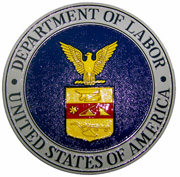NATIONAL
Union membership drops; Washington state still No. 4
WASHINGTON, D.C. (Jan. 23, 2013) — As federal, state and local governments continued to layoff public employees in 2012, the number of union members dropped by 400,000 to 14.4 million last year, according to the latest report from the U.S. Department of Labor’s Bureau of Labor Statistics. The rate of union membership dropped to 11.3%, down from 11.8% in 2011.
 In the state-by-state breakdown, Washington state remains ranked No. 4 in terms of union density in 2012, with the state’s 513,000 union members accounting for 18.5% of the overall workforce. Only New York (23.2%), Alaska (22.4%) and Hawaii (21.6%) and have higher unionization rates than Washington. Neighboring Oregon ranks 9th in union density (15.7%).
In the state-by-state breakdown, Washington state remains ranked No. 4 in terms of union density in 2012, with the state’s 513,000 union members accounting for 18.5% of the overall workforce. Only New York (23.2%), Alaska (22.4%) and Hawaii (21.6%) and have higher unionization rates than Washington. Neighboring Oregon ranks 9th in union density (15.7%).
Total jobs in Washington increased 49,000 in 2012 from the previous year, according to the report, but the number of union members dropped by 4,000. That mirrored a national trend of lower union density in nearly every state in the country. Disproportionately high layoffs in the heavily unionized public sector — which has a 35.9% unionization rate, five times higher than the private sector — accounted for much of the change.
“While it’s always encouraging that Washington remains one of the most unionized states in the country, these numbers demonstrate how public-sector layoffs have eroded away middle-class unionized jobs,” said Jeff Johnson, President of the Washington State Labor Council, AFL-CIO. “As the economy slowly recovers, our state has seen hiring step up in highly unionized sectors like commercial construction and aerospace manufacturing, but those gains were offset by thousands of jobs lost at Hanford when the stimulus money ran out and thousands more jobs cut from state and local government.”
With recession-related layoffs, the number of state employees in Washington has already been cut to the lowest level in a decade or more. As private sector hiring has picked up in the past year, continuing government layoffs have been cited as a drag on the state and national economies that is prolonging the recession and slowing private-sector growth. The new data shows those layoffs have affected unionization rates as well.
“The bottom line is that the all-cuts budgets being approved at the state and local levels are not only harming the quality of public services, they are also costing us thousands of precious middle-class jobs and slowing our economic recovery,” Johnson added. “Public employees have taken a terrific hit by right wing-led state agendas, meanwhile federal job cuts have increased because Republicans in Congress refuse to vote for a jobs agenda and safety net agenda. The real shame is that workers more than ever need the strength and protection of union membership.”
The new report also bears out the fact that union membership means higher wages.
In 2012, among full-time wage and salary workers, union members had median usual weekly earnings of $943, while those who were not union members had median weekly earnings of $742 or more than 20% less than union members.
For more information about joining a union, click here.





